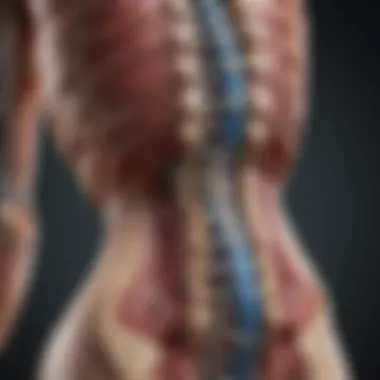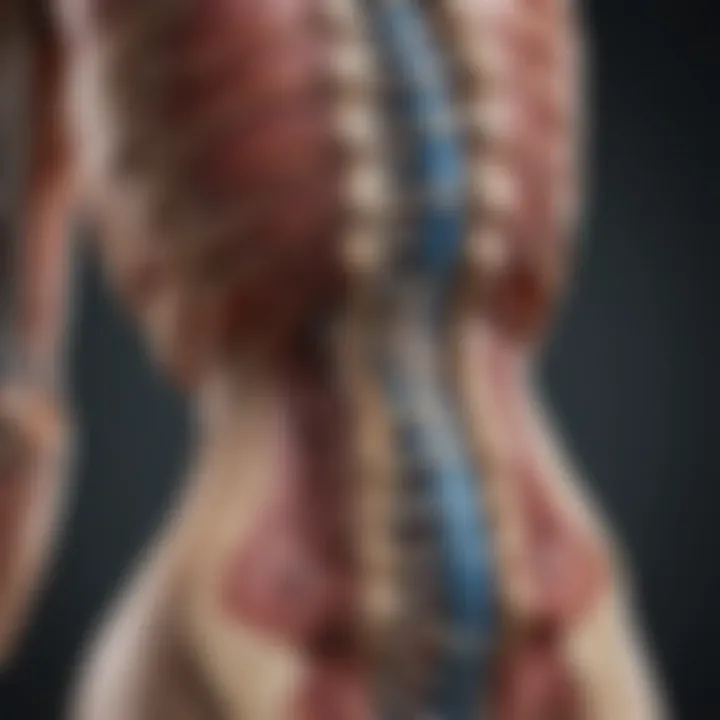The Link Between Low Back Pain and Fatigue


Intro
Low back pain and fatigue are two distinct yet frequently intertwined issues that many experience in their day-to-day lives. Low back pain is often a nagging thorn in several people's sides, affecting their ability to perform daily tasks. Fatigue, on the other hand, saps one's energy and motivation, leading to a feeling of constant tiredness. Understanding the links between these two conditions is essential, not just for the individuals suffering from them, but also for healthcare professionals seeking innovative solutions to improve quality of life.
As we embark on this exploration, it’s key to note how low back pain does not only hinder physical activities but is also linked to sleep disruptions, which can exacerbate fatigue. Conversely, persistent fatigue can severely impede one’s ability to handle pain pain. This cyclical nature raises numerous questions: How do these conditions influence each other? What underlying factors contribute to their co-existence? And most importantly, what management strategies can help alleviate both?
This article will dissect each facet of this relationship, aiming to unveil crucial insights about how physical, psychological, and lifestyle aspects interplay, ultimately impacting individuals' daily lives. By peeling back the layers, one can better understand both the causes and solutions, providing a clearer path to relief.
Understanding Low Back Pain
Low back pain is a topic that resonates with many. It has creeping effects, reaching not just the physical realm but also impacting emotional well-being and daily functioning. Understanding low back pain is key to unraveling the complex relationship it has with fatigue.
When we take time to delve into the nature of low back pain, we unveil a host of contributing factors. The body isn’t just a collection of parts; it’s an intricate system where multiple elements intertwine. By comprehending the roots and ramifications of low back pain, individuals are better equipped to manage it effectively. Addressing this issue can enhance overall quality of life and assist patients in reclaiming their zest for daily activities.
Definition and Prevalence
Low back pain generally refers to pain that occurs between the bottom rib and the top of the legs. It may manifest with varying intensity, from a dull ache to sharp sensations, and poses an enormous burden on both individuals and healthcare systems worldwide.
In terms of prevalence, statistics suggest that about 80% of people will experience low back pain at some point in their lives. Economic implications are considerable, leading to lost workdays and strained healthcare resources. Thus, its widespread nature emphasizes the urgency for deeper understanding and effective intervention.
Common Causes of Low Back Pain
Low back pain can arise due to a plethora of reasons. Some common causes include:
- Muscle or Ligament Strain: Often results from heavy lifting or an awkward movement.
- Bulging or Ruptured Discs: Discs act as cushions between the vertebrae, and damage can occur over time.
- Arthritis: Conditions like osteoarthritis may trigger lower back discomfort and stiffness.
- Skeletal Irregularities: A condition such as scoliosis may cause pain over the years.
- Other Medical Conditions: Infections or cancers, though less common, can lead to significant discomfort.
Recognizing these causes is crucial as they can influence the way low back pain is experienced and managed.
Types of Low Back Pain
Low back pain is not a monolith; it has various manifestations. To better grasp this condition, we categorize it into distinct types:
Acute vs. Chronic Pain
Acute pain typically crops up suddenly and lasts for not longer than six weeks. It's often linked to an injury, a slip, or overexertion. The key characteristic of acute pain is its temporary nature, making it often a responsive signal to safeguard the body.
On the other hand, chronic pain persists much longer, generally defined as pain lasting beyond three months. Chronic low back pain can evolve from an untreated acute condition or arise separately without any identifiable cause. Its complexity lies in the potential for psychological implications, contributing to ongoing fatigue and limitation of activities.
Acute pain might be thought of as a fire alarm; your body is telling you something’s awry just for a short while. Chronic pain resembles that incessant buzzing sound that won't go away. Understanding the distinction between these two types offers insights into coping strategies and recovery processes.
Localized vs. Radiating Pain
Localized pain is confined to a specific area, making it easier to pinpoint. This type often suggests muscle strain or structural problems, allowing for targeted treatment.
Radiating pain, in contrast, can extend from the low back down into the legs. Nerve irritation often causes it, which can lead to more complications, including numbness or weakness in the legs. This differentiation is beneficial because it steers the diagnosis and treatment approaches.
When faced with low back pain, determining its nature can drastically alter the treatment plan and recovery outlook.
Muscle vs. Nerve Related Pain
Differentiating between muscle-related pain and nerve-related pain is vital in addressing low back pain effectively. Muscle pain tends to feel sore and achy, often stemming from overuse or injury. It generally has a clear cause.
Conversely, nerve pain can manifest as sharp, burning sensations or tingling. Often, it arises when nerves are compressed or irritated, leading to more complex conditions that may require specialized interventions. Highlighting this difference allows for proper diagnosis, which is the bedrock of successful management and rehabilitation strategies.
By breaking down these types of low back pain, we set the stage for a deeper exploration into how these conditions can intertwine with fatigue, revealing patterns and shared pathways.
The Physiology of Fatigue
Understanding the physiology of fatigue is crucial, especially in the context of low back pain. Fatigue itself isn't just a feeling of tiredness; it's a complex phenomenon tied to various bodily systems. It serves as a window into how our body copes with stressors, which can be physical or mental.
When fatigue sets in, it often signals that the body needs rest or a change in activity. This insight is especially valuable for individuals who experience chronic low back pain, as fatigue can amplify pain perception and complicate recovery. Through exploring how these two conditions are intertwined, we can appreciate not only the symptoms but also the underlying mechanisms that could guide more effective management strategies.
Defining Fatigue
Fatigue can be defined as a state of weariness that reduces the capability for physical or mental work. This aspect is essential when considering the interconnection with low back pain. Fatigue may arise after extensive physical exertion or even as a consequence of emotional stress, forming a barrier to daily activities.
“Fatigue is not just a symptom. It’s a signal from the body that demands attention and adjustment.”
Types of Fatigue
Understanding the different types of fatigue sheds light on their overlapping influences on health.


Physical Fatigue
Physical fatigue refers to that tiredness felt after strenuous activities. It often leads to decreased muscle strength and can impact overall physical capabilities. One main characteristic of physical fatigue is that it usually improves with rest. Its significance lies in its role; it can be a critical factor in low back pain rehabilitation.
For instance, those recovering from low back injuries may find that as their physical fatigue increases, they tend to limit their movements. The unique feature of this fatigue is that it often serves as a protective mechanism—warning the body against overexertion. However, while rest can offer relief, too much inactivity can be detrimental, causing muscle weakness and stiffness, potentially worsening low back pain.
Mental Fatigue
Mental fatigue is characterized by a lack of motivation and cognitive slowdown. This form of fatigue often stems from prolonged mental exertion, stress, or frustration, factors that are common in individuals dealing with low back pain.
One key characteristic is the difficulty in maintaining focus, which can lead to poor decision-making and further indirect consequences like unhealthy lifestyle choices. Mental fatigue can be equally impactful as physical fatigue, warranting equal consideration in comprehensive management plans. For example, someone grappling with low back pain might find it hard to engage in necessary physical therapy if mental fatigue hampers their focus and resolve.
Ultimately, while mental fatigue can lessen with breaks or restorative activities, ignoring it can lead to a downward spiral affecting both mental health and pain outcomes.
Chronic Fatigue Syndrome
Chronic Fatigue Syndrome, or CFS, represents a long-lasting form of fatigue that severely limits daily activities. It's defined by profound fatigue lasting six months or longer, often accompanied by sleep disturbances or cognitive impairment. It's a complex disorder, and the connection to low back pain can present challenges for both patients and healthcare providers.
One notable characteristic is that the fatigue experienced in CFS isn't simply alleviated by rest. Unlike the other types of fatigue, the unique feature of CFS is this persistent, unyielding nature, which contributes to a notably decreased quality of life.
In the context of low back pain, understanding CFS becomes critical due to overlapping symptoms. Those with both conditions might struggle in articulating the multifaceted nature of their fatigue, making diagnosis and appropriate management increasingly complex.
Biological Mechanisms of Fatigue
The biological mechanisms underlying fatigue are intricate and involve a multitude of forces—hormonal fluctuations, energy depletion, and immune responses all come into play. Factors such as inflammation may also exacerbate both fatigue and pain, thereby reinforcing the disharmony between the two.
Biofeedback could illuminate pathways by which fatigue affects pain and vice versa, offering key insights into developing tailored approaches to treatment.
Grasping these interconnected biological mechanisms not only enhances the understanding of symptoms but also illuminates potential pathways for intervention, critical for effective management in patients suffering from both low back pain and fatigue.
The Link Between Low Back Pain and Fatigue
Understanding the connection between low back pain and fatigue is crucial. These two conditions often go hand in hand, creating a cycle that can be difficult to escape.
People dealing with chronic low back pain frequently report higher levels of fatigue, while those experiencing fatigue may complain of increased discomfort in their lower back. This intersection affects not only the physical well-being of individuals but also their mental capacity and overall quality of life.
Furthermore, by digging into this link, we can uncover potential therapeutic avenues. Recognizing the interplay between these two issues can lead to a more rounded approach in treatment, enabling healthcare providers to address both aspects effectively.
Shared Physiological Pathways
Low back pain and fatigue share several physiological pathways, which can include inflammation, hormonal changes, and neurological responses. For instance, inflammation is a common underlying factor in many cases of both chronic pain and fatigue. When pain signals are constantly sent to the brain, they may trigger the release of cortisol, the stress hormone. Elevated cortisol levels can subsequently lead to fatigue and a general sense of malaise.
Additionally, neuromuscular adaptations that occur as a result of pain might change the body's metabolic demands. This altered state affects overall energy levels and can lead a person to feel exhausted, even after minimal effort.
Psychological Effects and Feedback Loops
The psychological interplay between low back pain and fatigue cannot be overlooked. Both conditions tend to create negative feedback loops. When someone is in pain, they may feel more fatigued, which can then exacerbate their perception of pain.
Patients often report feelings of anxiety or depression in relation to their pain and fatigue. This mental burden contributes to a state of chronic stress, which can worsen both symptoms, creating an environment where recovery becomes increasingly challenging.
Lifestyle Influences
Lifestyle choices significantly contribute to the experience of both low back pain and fatigue. Examining these influences offers insights into preventive measures and management strategies.
Sedentary Behavior
Sedentary behavior is a major concern when looking at low back pain and fatigue. Prolonged periods of inactivity can lead to muscle atrophy and decreased physical conditioning, thereby increasing the risk of low back pain. This kind of behavior is often more than just a series of unfortunate choices; it stems from modern lifestyles that prioritize convenience.
The uniqueness of sedentary behavior lies in its widespread presence in many people's day-to-day lives. Commuting by car, extended office hours without breaks, and leisure time spent on screens all contribute. The inherent disadvantage here is clear: while a sedentary lifestyle may seem comfortable in the short term, it significantly compromises physical health and results in increased fatigue over time.
Sleep Quality
Sleep quality directly influences both low back pain and fatigue. A poor sleep environment or insufficient sleep can diminish one's ability to cope with pain, leading to heightened fatigue the next day. Sleep is not just a period of rest but an essential process for recovery and healing.
Factors such as sleep position, mattress choice, and bedroom ambiance play a vital role in sleep quality. If one is awakening with back pain, it can signal suboptimal conditions, ultimately spiraling into fatigue. The interplay here is notable—poor sleep leads to increased sensations of pain which, in turn, manifests as greater fatigue during waking hours.
Nutrition
Nutrition is another influential factor in the relationship between low back pain and fatigue. The body requires essential nutrients to maintain not only energy levels but also muscle health and overall well-being. A diet high in processed foods may lead to inflammation, further exacerbating pain conditions.
The aspect of good nutrition is characterized by incorporating a variety of whole foods, which provide vitamins and minerals necessary for recovery. Additionally, staying hydrated plays a pivotal part in maintaining energy levels. However, balanced nutrition often takes a backseat in modern fast-paced lifestyles, contributing to low back pain and fatigue.
Diagnosis and Assessment


In the realm of health, understanding the nuances of conditions like low back pain and fatigue requires a structured approach. Diagnosis and assessment play critical roles, providing a framework through which practitioners can elucidate underlying issues. It’s essential to evaluate patients effectively for several reasons.
First off, an accurate diagnosis can steer the treatment plan in the right direction, ensuring that the interventions chosen address the specific conditions afflicting the patient. The relationship between low back pain and fatigue often intertwines; therefore, a thorough assessment is vital for identifying not just the symptoms but also the root causes. This dual-focus means assessment isn’t just a checklist – it’s an intricate process that encompasses clinical insight, patient history, and sometimes even collaborative multidisciplinary evaluations.
Secondly, effective diagnosis improves communication between healthcare providers and patients. Understanding the origins of pain and fatigue can empower patients, leading to active involvement in their management strategies. Through sharing information about their conditions, individuals can also reduce anxiety surrounding their symptoms, potentially alleviating some psychological components of both low back pain and fatigue.
Clinical Evaluation of Low Back Pain
Evaluating low back pain begins with a thorough clinical assessment. This process typically involves several key steps:
- Patient History: Gathering detailed information on the onset, duration, and intensity of pain is paramount. This establishes a foundational understanding that guides subsequent investigations.
- Physical Examination: Here, healthcare providers will assess posture, mobility, and any movement restrictions. Strength tests and reflex checks may also help pinpoint issues related to nerve compression or muscle weakness.
- Diagnostic Imaging: In some cases, doctors may suggest imaging studies, such as X-rays or MRIs, to visualize anatomical anomalies or degenerative changes in the spine. These tools provide invaluable insight but should be interpreted within the context of clinical findings.
The goal of this detailed evaluation is to rule out serious conditions while identifying contributing factors of pain. As the age-old saying goes, “knowledge is power,” and in diagnosis, it proves to be true time and again.
Assessing Fatigue: Tools and Methods
When addressing fatigue, assessment tools can help quantify the fatigue levels and gain a clearer picture of the individual’s experience. Two notable tools include:\
Fatigue Severity Scale
The Fatigue Severity Scale (FSS) is particularly beneficial for understanding the impact of fatigue on daily function.
- Key Characteristic: This scale employs a straightforward, self-reported questionnaire format, allowing individuals to express the severity of their fatigue on a scale.
- Unique Feature: One standout aspect of the FSS is its sensitivity to changes over time. By tracking scores, practitioners can evaluate how interventions may be affecting fatigue levels, illustrating progress or the need for adjusted approaches.
- Advantages: Its simplicity makes it a popular choice - patients can typically complete it in a matter of minutes, enabling quick analysis.
However, its self-report nature could lead to variability based on individual perceptions of fatigue. It’s essential to consider this context when interpreting results.
Patient Health Questionnaires
The Patient Health Questionnaires (PHQ) serve as another valuable tool not just for assessing general health, but also for capturing fatigue related to psychological factors such as depression and anxiety.
- Key Characteristic: Specifically, the PHQ-9 is often used to gauge how fatigue interrelates with mood disorders, proving beneficial in a comprehensive assessment context.
- Unique Feature: It incorporates questions related to both mood and energy levels, making it versatile for diagnosing underlying psychological issues that contribute to fatigue.
- Advantages: The PHQ can spark discussions regarding mental health, opening doors for treatment options that encompass both psychological and physical strategies.
Nonetheless, depending on the population and context, there might be concerns about over-diagnosing or misinterpreting fatigue related to emotional states.
Differentiating Between Pain-Related Fatigue and Other Types
When evaluating fatigue in patients with low back pain, it’s crucial to differentiate pain-related fatigue from other types. Pain-related fatigue is often characterized by a direct correlation with the intensity and frequency of pain episodes. This contrasts with fatigue stemming from other sources, such as lifestyle factors or psychological conditions.
Understanding this distinction is critical for tailoring effective interventions. Healthcare providers often consider:
- Patient History: Identifying patterns in fatigue onset related to pain episodes versus independent fatigue from, say, chronic stress or poor sleep habits.
- Physical Assessment: Assessing mobility limitations and how they might contribute to energy depletion or emotional distress.
- Psychological Evaluation: Considering the role of mood and mental health as influential players in the fatigue landscape.
Recognizing these different types can lead to more targeted management strategies, emphasizing the importance of a comprehensive assessment that goes beyond surface-level symptoms.
In essence, the interplay of diagnosis and assessment is a cornerstone in unraveling the complex associations between low back pain and fatigue, fostering an informed approach to treatment that not only addresses symptoms but informs holistic care.
When one starts evaluating these connections, one realizes that knowing how to interpret the various aspects of assessment brings light into an otherwise shadowy realm.
Management Strategies
Exploring ways to manage low back pain and its related fatigue is essential for improving a person’s quality of life. This section looks at various approaches that can help address both issues. The right strategy can provide relief while allowing individuals to regain control of their daily activities. Considering both conventional treatments and alternative methods, a comprehensive management plan may often yield the best results.
Conventional Medical Treatments
Medications
Medications play a crucial role in managing low back pain. Analgesics like acetaminophen and nonsteroidal anti-inflammatory drugs (NSAIDs) are commonly used for pain relief. Their key characteristic is their ability to reduce pain and inflammation, which can also indirectly help reduce fatigue caused by discomfort.
While medications are beneficial for short-term use, they may have certain drawbacks, like potential addiction or adverse reactions. Therefore, healthcare providers often recommend combining medications with other treatment methods for a well-rounded approach. The unique feature of medications is how they can quickly alleviate symptoms, bringing immediate comfort to individuals, but dependency on them can sometimes lead to complications.
Physical Therapy
Physical therapy is another integral part of managing low back pain and associated fatigue. A licensed physical therapist develops a customized rehabilitation program that focuses on improving strength, flexibility, and posture. The key characteristic of physical therapy is its emphasis on movement; it aims to restore function and mobility without surgery.
The unique aspect of physical therapy is its long-term benefits. While it may take time to see results, patients often find that sustained sessions improve their overall well-being and decrease pain levels over time. However, the commitment to follow-through can be challenging for some individuals, as therapy regimens may require consistent effort.
Alternative and Complementary Approaches
Chiropractic Care
Chiropractic care offers an alternative method to manage low back pain, focusing on spinal alignment and manipulation. This method is based on the idea that proper alignment can lead to the body functioning optimally, potentially reducing both pain and fatigue. The key characteristic of chiropractic care is its non-invasive nature, relying on adjusting the spine to relieve pressure on nerves.


Its unique feature is the emphasis on a holistic approach to wellness. Patients often report improved mobility and reduced pain following chiropractic adjustments. However, it is important to note that not all individuals respond similarly to treatment, and what works for one person may not work for another.
Acupuncture
Acupuncture serves as a time-tested method rooted in ancient Chinese medicine, addressing both low back pain and fatigue. It involves inserting thin needles into specific body points to promote healing and balance. Its key characteristic lies in its ability to stimulate the body's natural painkillers, contributing to pain reduction while potentially improving energy levels.
Acupuncture's unique feature is its holistic approach. Many patients find that it not only helps with pain but can also enhance relaxation and reduce stress levels. However, some may experience discomfort during treatment, and the effects can vary, leading to mixed reviews over its efficacy.
Lifestyle Modifications
Exercise Regimens
Regular exercise regimens offer an essential component in managing low back pain and fatigue. Programs tailored to strengthen core muscles can be particularly effective, as they support the spine. The key characteristic of these regimens is their adaptability—there are various types suitable for differing fitness levels.
The unique feature of exercise is its dual benefit; while it targets pain relief, it also combats fatigue by improving overall fitness. The downside may be starting a new exercise routine, which can sometimes lead to initial discomfort or misplaced expectations of rapid results.
Ergonomic Adjustments
Making ergonomic adjustments at work or home is vital for preventing and managing low-back issues. This can mean altering workstation setups to promote better posture. The key characteristic lies in creating an environment that reduces strain on the back during regular activities.
The unique aspect of ergonomic adjustments is their preventative nature, which is especially important for those with sedentary jobs. When implemented correctly, they can greatly lower the risk of developing chronic pain. However, changes might take time for individuals to adapt, making patience necessary during the transition.
Stress Management Techniques
Lastly, stress management techniques are integral in addressing fatigue related to low back pain. Stress can amplify pain perception, creating a vicious cycle. Techniques like mindfulness, meditation, or yoga can promote relaxation. Their key characteristic is how they encourage mental well-being, indirectly leading to physical improvement.
The unique feature of these techniques is that they are often accessible and can be done independently. However, commitment to regular practice is vital to see substantial benefits, which can be a hurdle for busy individuals.
For those struggling with low back pain and fatigue, a multifaceted approach is key. Engage in different strategies, from medications and therapy to lifestyle changes, to discover what works best.
Research and Future Directions
Exploring the connections between low back pain and fatigue is paramount, not just for individuals suffering, but also for evolving treatment methodologies in healthcare. This section will elaborate on the significance of understanding these links, the innovations in research currently being pursued, areas ripe for future investigation, and notable advancements in the field of pain and fatigue studies.
When examining this topic, it is crucial to consider how a deeper grasp of the interplay between these two conditions can shape better therapeutic approaches. The implications of research could lead to enhanced patient care, more effective pain management strategies, and an overall improvement in quality of life for many individuals.
Moreover, it’s apparent that the journey toward understanding this relationship is still ongoing, with new insights shedding light on how physical and mental health intricately intertwine.
Current Research Trends
The field currently sees a surge in research focusing on the biochemical markers related to pain and fatigue. For example, studies are increasingly examining inflammatory responses and how these factors might be linked to chronic conditions. Researchers are utilizing advanced imaging techniques to visualize how pain pathways react over time, providing valuable insights that were previously out of reach.
Additionally, the psychological aspects are coming into play. Many studies are now addressing how cognitive and behavioral therapies can influence both pain perception and fatigue levels, encouraging a more holistic view of treatment. This includes explorations into mindfulness and its effect on these conditions. The findings thus far indicate a promising avenue for reducing both pain and fatigue through mental wellness approaches.
Potential Areas of Exploration
As we look towards the horizon, several avenues stand out as particularly promising for future inquiry. One significant area is the potential genetic predisposition to both low back pain and fatigue. Understanding any correlation here could unlock new preventive strategies and sharpen targeted treatments.
Another area is the synergy of lifestyle interventions. The relationship between exercise, nutrition, and their combined effect on pain and energy levels needs more exploration. Questions about how different forms of physical activity impact these conditions are still not fully answered. Just how much does fatigue influence the willingness or capability to engage in physical rehabilitation?
Furthermore, an investigation into the cognitive load imposed by chronic pain could reveal much about the fatigue it generates. Are there specific pain strategies that can alleviate mental fatigue? Addressing these considerations will enrich not only our theoretical understanding but will also practically improve patient care.
Advancements in Pain and Fatigue Studies
There has been notable progress in the methods employed to study pain and fatigue. For instance, the development of wearable technology has made it easier to gather real-time data on patients' experiences. Such tools allow for a more in-depth understanding of how daily activities affect both conditions, offering valuable feedback that can be used in clinical settings.
Moreover, the rise of integrative medicine is providing a broader platform for multidisciplinary collaborations. This fusion includes combining physical therapy, nutritional counseling, and psychological support to form comprehensive care protocols that acknowledge the nuanced relationship between low back pain and fatigue.
Advances in the understanding of cellular patterns related to chronic pain could also pave the way for new pharmacological approaches. Investigating how certain compounds affect neuroinflammation or discomfort could lead to better treatment options.
All these paths in research and development point toward a future where patient care is not only more nuanced but also more personalized, addressing the unique interplay between low back pain and fatigue for each individual.
Ending
In assessing the intricate relationship between low back pain and fatigue, it becomes clear that both conditions are not merely isolated experiences. Rather, they are entwined in a complex web of physiological, psychological, and lifestyle factors that can significantly impact an individual's quality of life.
Summary of Key Points
Firstly, understanding how low back pain can lead to fatigue lies in recognizing not only the physical limitations imposed by pain but also the mental toll it takes on individuals. It’s not uncommon for someone suffering from persistent back pain to feel drained, as the body expends energy simply managing discomfort.
Secondary, the overlapping mechanisms—both biological and psychological—contribute to the cyclical nature of these issues. In many cases, fatigue can heighten sensitivity to pain, leading to a downward spiral that affects both emotional resilience and physical function. This interaction suggests a need for holistic assessment and management, rather than treating each issue in isolation.
Additionally, lifestyle factors play a critical role. Sedentary behavior, poor sleep, and inadequate nutrition can exacerbate symptoms of both low back pain and fatigue. By focusing on enhancing these lifestyle elements, individuals may find they can impact their overall well-being significantly, suggesting that effective management strategies must encompass more than just pharmaceutical interventions.
Final Thoughts on Management and Awareness
The importance of awareness and comprehensive management cannot be understated. Those experiencing low back pain and fatigue should be encouraged to communicate openly with healthcare providers, sharing insights and observations about how these conditions interconnect in their lives. Education about effective lifestyle modifications is crucial—whether it's through establishing an ergonomic workspace, engaging in regular physical activity, or practicing stress management techniques.
Furthermore, ongoing research remains imperative in uncovering new links and treatment options. By staying informed and proactive, patients and professionals alike can foster a more integrated approach to care, enhancing outcomes and enriching lives affected by these prevalent conditions. As we deepen our understanding of this dialogue between pain and fatigue, we not only empower those in need but also pave the way for more effective and compassionate healthcare solutions.







